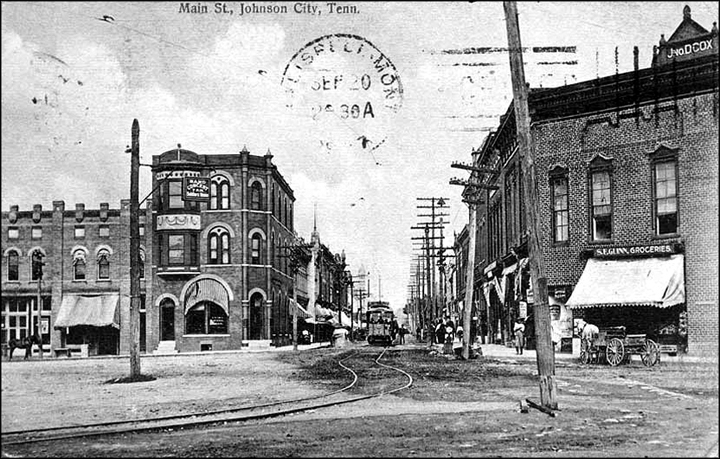Johnson City's mayor in 1908 was Guy L. Smith, who also worked for the Armbrust-Smith Co, a furniture store at 204-06 E. Main (much later the site of Nettie Lee's Boy and Girl Shop). If we could somehow ask Mr. Smith what Johnson City was like soon after the turn of the twentieth century, he would likely answer us like this:
“Johnson City is located in Washington County, the oldest and first settled in the state. It was in this county in 1771 that a colony set up and established the first free and independent government, known as the Watauga Association. It was also the home at one time of Andrew Jackson and of Davy Crockett.
“Johnson City is situated on the Southern Railway, 106 miles northeast of Knoxville and about 25 miles from both the Virginia and North Carolina state lines. Its growth in population in a single decade increased from 637 to 4,150 and the population in the last few years has more than doubled. As of today, we are the third largest town in East Tennessee and already being called “The Coming City of the South, a designation all of us love to hear.”
“Johnson City's altitude is 1,650 feet above sea level, it being located in the foothills of the Southern Appalachian Mountains. These mountains with their subordinate ranges are in full view of the city. In both scenery and climate, it is very similar to Asheville, NC. A significant plus for this section of the country is its cool nights in the summer and its freedom from malaria, mosquitoes and epidemics.

Main Street Looking East in 1908 Johnson City
“Protected by the Allegheny Mountains on the east and the Cumberland Mountains on the west, this area is the least visited by destructive winds of any in the Union. Because of its altitude, summer temperatures are much lower than those recorded in the cities of the north.
“Near Johnson City, within an hour ride by train, are some of the most noted summer resorts in the country. The majestic Cloudland Hotel on the top of Roan Mountain, the highest habitable point east of the Rocky Mountains at an elevation of 6,300 feet, is a celebrated resort for sufferers of hay fever and malaria.
“Another notable resort is Linville, NC, located at the foot of Grandfather Mountain (elevation 5,000 feet). Unaka Springs, 20 miles distant, located at the foot of several towering peaks on the banks of the Nolachucky River, is resorted to for its medicinal spring. Not to be omitted are Austin and King springs whose healthful waters are principally Chalybeate and Lithia.
“Johnson City has five railroads:
“1. The line from the Southern Railway from Washington, DC to Knoxville, Memphis and New Orleans, passes through the city, putting us in direct contact with every municipality on that great system.
“2. The ET&WNC Railroad runs from Johnson City through Cranberry, NC, where is found the finest body of magnetic iron ore in America, and on to other points in North Carolina. The general offices are in Johnson City.
“3. The Virginia and Southwestern is now a branch of the Southern Railway and reaches the city on the tracks of that system.
“4. The Johnson City Southern connects the city with the Embreeville furnaces.
“5. The CC&O Railway, still under construction, is correlated with the Seaboard Air Line and will extend from the coal fields of Southwest Virginia to the Atlantic Coast.
“A new Federal building has been erected in the city and plans have been drawn for the erection of a Union Passenger depot at a cost of $100,000. In addition to a recently installed modern sewer and water system, we have paved many streets and laid several blocks of sidewalks. Already in place are substantial business blocks, progressive banks, a thorough education system, elegant and costly church edifices, splendid retail stores and many beautiful modern homes.
“Johnson City is destined to become a manufacturing center because of a strong and steady inflow of population. The three competing trunk lines entering the city offer affordable rates to all points. It supplies coal, thus securing for manufactures a permanent and unfailing fuel supply. The Nolachucky, Watauga and Holston rivers, which are close at hand, afford power sites of immense value.
“The surrounding deposits of minerals, the great variety and supply of hardwoods, cheap and abundant labor make Johnson City 'The Coming City of the South.”'
I think most of us would concur that Johnson City has more than lived up to its 1908 expectations.
